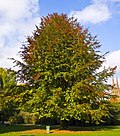Fagaceae
Fagaceae is a family of flowering plants known as the beech family. This family includes a number of important genera, such as Quercus (oaks), Fagus (beeches), Castanea (chestnuts), and Corylus (hazels). Members of the Fagaceae family are predominantly trees and shrubs, characterized by their simple, alternate leaves, which are often lobed or toothed. They are found in temperate regions of the Northern Hemisphere, with a few species extending into the tropics.
Description[edit]
Plants in the Fagaceae family exhibit a wide range of growth forms, from towering trees to small shrubs. Their leaves are typically simple, with a serrated or smooth margin, and are arranged alternately on the branches. The flowers of Fagaceae species are usually small and inconspicuous, with separate male and female flowers that may be on the same plant (monoecious) or on different plants (dioecious). The fruit of these plants is often a nut, such as the acorn of oaks or the beechnut of beech trees, usually enclosed in a hard or spiny cupule.
Ecology[edit]
Fagaceae species play a crucial role in their ecosystems. Oaks, for example, provide habitat and food for a wide variety of wildlife. The acorns produced by oaks are a significant food source for numerous birds, mammals, and insects. Similarly, beech nuts are consumed by wildlife, including birds, squirrels, and deer. The presence of Fagaceae species can influence the structure and composition of forests, affecting biodiversity and ecosystem services.
Economic Importance[edit]
Several members of the Fagaceae family have considerable economic value. Oaks are widely used in furniture making, flooring, and for barrels in which wines and spirits are aged. Chestnuts, both the wood and the nuts, have been used by humans for thousands of years. The wood is valued for its durability and resistance to rot, while the nuts are consumed roasted or used in cooking. Hazelnuts are another economically important product, widely used in confectionery and baking.
Conservation[edit]
Some species within the Fagaceae family are threatened by habitat loss, climate change, and diseases. The American chestnut (Castanea dentata), for example, has been decimated by chestnut blight, a fungal disease. Conservation efforts are underway to restore these populations through breeding programs and habitat protection. The preservation of Fagaceae species is vital for maintaining biodiversity, ecosystem health, and the economic benefits they provide.
See Also[edit]
Fagaceae[edit]
-
European Beech
Ad. Transform your life with W8MD's Budget GLP-1 injections from $75


W8MD offers a medical weight loss program to lose weight in Philadelphia. Our physician-supervised medical weight loss provides:
- Weight loss injections in NYC (generic and brand names):
- Zepbound / Mounjaro, Wegovy / Ozempic, Saxenda
- Most insurances accepted or discounted self-pay rates. We will obtain insurance prior authorizations if needed.
- Generic GLP1 weight loss injections from $75 for the starting dose.
- Also offer prescription weight loss medications including Phentermine, Qsymia, Diethylpropion, Contrave etc.
NYC weight loss doctor appointmentsNYC weight loss doctor appointments
Start your NYC weight loss journey today at our NYC medical weight loss and Philadelphia medical weight loss clinics.
- Call 718-946-5500 to lose weight in NYC or for medical weight loss in Philadelphia 215-676-2334.
- Tags:NYC medical weight loss, Philadelphia lose weight Zepbound NYC, Budget GLP1 weight loss injections, Wegovy Philadelphia, Wegovy NYC, Philadelphia medical weight loss, Brookly weight loss and Wegovy NYC
|
WikiMD's Wellness Encyclopedia |
| Let Food Be Thy Medicine Medicine Thy Food - Hippocrates |
Medical Disclaimer: WikiMD is not a substitute for professional medical advice. The information on WikiMD is provided as an information resource only, may be incorrect, outdated or misleading, and is not to be used or relied on for any diagnostic or treatment purposes. Please consult your health care provider before making any healthcare decisions or for guidance about a specific medical condition. WikiMD expressly disclaims responsibility, and shall have no liability, for any damages, loss, injury, or liability whatsoever suffered as a result of your reliance on the information contained in this site. By visiting this site you agree to the foregoing terms and conditions, which may from time to time be changed or supplemented by WikiMD. If you do not agree to the foregoing terms and conditions, you should not enter or use this site. See full disclaimer.
Credits:Most images are courtesy of Wikimedia commons, and templates, categories Wikipedia, licensed under CC BY SA or similar.
Translate this page: - East Asian
中文,
日本,
한국어,
South Asian
हिन्दी,
தமிழ்,
తెలుగు,
Urdu,
ಕನ್ನಡ,
Southeast Asian
Indonesian,
Vietnamese,
Thai,
မြန်မာဘာသာ,
বাংলা
European
español,
Deutsch,
français,
Greek,
português do Brasil,
polski,
română,
русский,
Nederlands,
norsk,
svenska,
suomi,
Italian
Middle Eastern & African
عربى,
Turkish,
Persian,
Hebrew,
Afrikaans,
isiZulu,
Kiswahili,
Other
Bulgarian,
Hungarian,
Czech,
Swedish,
മലയാളം,
मराठी,
ਪੰਜਾਬੀ,
ગુજરાતી,
Portuguese,
Ukrainian

